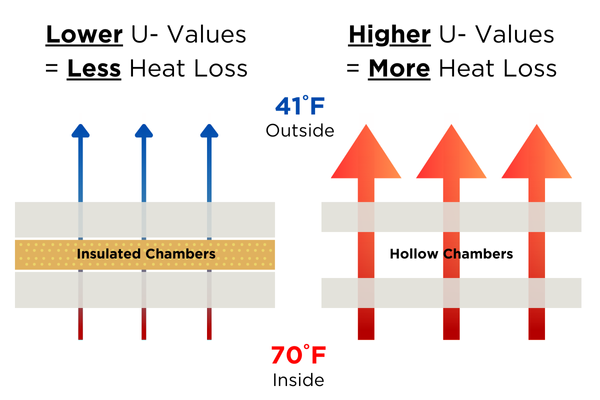U-Factor vs. R-Value: Understanding Window Insulation
Windows are one of the biggest sources of energy loss in homes. Which is why, if you want to improve energy efficiency in your home, it’s important to understand the difference between U-Factor vs. R-Value.
Both play a vital role in determining the insulation quality of your windows and overall energy performance. Below is some insight into these metrics to help you make informed buying decisions about window replacements.

A Window Replacement completed in 📍 Westerlo, NY.
What is U-Factor?
The U-Factor or U-Value measures the rate of heat transfer through a window.
It indicates how well the window insulates against non-solar heat flow. A lower U-Factor signifies better insulating properties, meaning less heat is lost during the winter and less heat enters during the summer. Some key points to consider about U-Factor include:
The U Factor is measured in BTUs per hour per square foot per degree Fahrenheit (BTU/h·ft²·°F).
High-performance windows often have U-Factor of 0.30 or lower, with some triple-pane windows achieving as low as 0.15.
Windows with low U-Factor reduce energy consumption and help maintain a consistent indoor temperature.
What is R-Value?
R-Value measures the resistance of a material to heat flow. The higher the R-Value, the better the material insulates. While R-Value is commonly associated with insulation in walls, roofs, and floors, it can also be applied to windows.
Some key points to know about R-Value include:
R-Value is the inverse of the U-Factor (R = 1/U).
A single-pane window might have an R-Value of 1, while double-pane windows can range from 2 to 4, and high-performance windows can reach up to 5.
Higher R-Values indicate better thermal resistance and increased energy efficiency.
U-Factor vs. R-Value: What Are the Main Differences?
While both U-Factor and R-Value provide insights into energy efficiency, they measure different aspects of insulation. U-Factor focuses on heat transfer rate through the entire window, including the frame, spacer, and glazing. R-Value, on the other hand, concentrates on the resistance to heat flow. It’s often used to compare the insulating performance of materials.
Importance of Window Insulation
Poorly insulated windows can lead to significant energy loss, making your heating and cooling systems work harder and your home less comfortable.
However, choosing windows with a good U-Factor and R-Value provides:
- Energy savings: Reduces the need for artificial heating and cooling, lowering energy bills.
- Comfort: Maintains a consistent indoor temperature, so rooms aren’t stuffy or drafty, enhancing comfort levels.
- Environmental impact: Reduces your carbon footprint by minimizing energy consumption, making your home more eco-friendly.
Get New Windows With Excellent U-Factors and R-Values
Understanding U-Factor vs. R-Value is key for making informed decisions when you’re buying new windows.
By choosing windows with optimal U-Factor and R-Value, you can enhance your home’s energy efficiency, reduce costs, and improve comfort. For more information about our energy-efficient window solutions, with excellent U-Factor and R-Value ratings, contact Yankee Home. Our team is ready to help you find the best replacement window options for your home.


